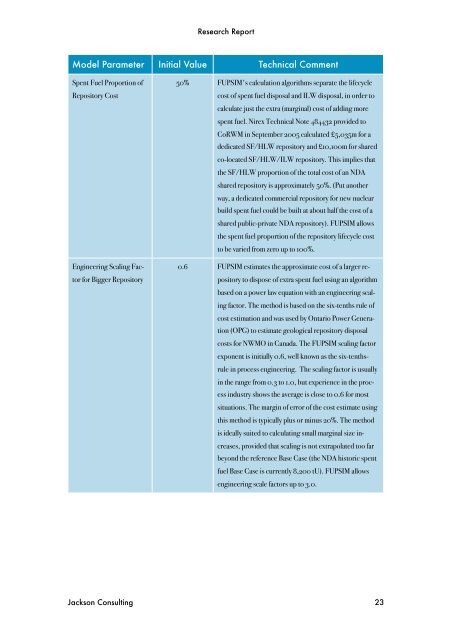fixed unit price simulation for disposal of spent fuel ... - Greenpeace UK
fixed unit price simulation for disposal of spent fuel ... - Greenpeace UK
fixed unit price simulation for disposal of spent fuel ... - Greenpeace UK
You also want an ePaper? Increase the reach of your titles
YUMPU automatically turns print PDFs into web optimized ePapers that Google loves.
Research Report<br />
Model Parameter Initial Value Technical Comment<br />
Spent Fuel Proportion <strong>of</strong><br />
Repository Cost<br />
Engineering Scaling Factor<br />
<strong>for</strong> Bigger Repository<br />
50% FUPSIM's calculation algorithms separate the lifecycle<br />
cost <strong>of</strong> <strong>spent</strong> <strong>fuel</strong> <strong>disposal</strong> and ILW <strong>disposal</strong>, in order to<br />
calculate just the extra (marginal) cost <strong>of</strong> adding more<br />
<strong>spent</strong> <strong>fuel</strong>. Nirex Technical Note 484432 provided to<br />
CoRWM in September 2005 calculated £5,035m <strong>for</strong> a<br />
dedicated SF/HLW repository and £10,100m <strong>for</strong> shared<br />
co-located SF/HLW/ILW repository. This implies that<br />
the SF/HLW proportion <strong>of</strong> the total cost <strong>of</strong> an NDA<br />
shared repository is approximately 50%. (Put another<br />
way, a dedicated commercial repository <strong>for</strong> new nuclear<br />
build <strong>spent</strong> <strong>fuel</strong> could be built at about half the cost <strong>of</strong> a<br />
shared public-private NDA repository). FUPSIM allows<br />
the <strong>spent</strong> <strong>fuel</strong> proportion <strong>of</strong> the repository lifecycle cost<br />
to be varied from zero up to 100%.<br />
0.6 FUPSIM estimates the approximate cost <strong>of</strong> a larger repository<br />
to dispose <strong>of</strong> extra <strong>spent</strong> <strong>fuel</strong> using an algorithm<br />
based on a power law equation with an engineering scaling<br />
factor. The method is based on the six-tenths rule <strong>of</strong><br />
cost estimation and was used by Ontario Power Generation<br />
(OPG) to estimate geological repository <strong>disposal</strong><br />
costs <strong>for</strong> NWMO in Canada. The FUPSIM scaling factor<br />
exponent is initially 0.6, well known as the six-tenthsrule<br />
in process engineering. The scaling factor is usually<br />
in the range from 0.3 to 1.0, but experience in the process<br />
industry shows the average is close to 0.6 <strong>for</strong> most<br />
situations. The margin <strong>of</strong> error <strong>of</strong> the cost estimate using<br />
this method is typically plus or minus 20%. The method<br />
is ideally suited to calculating small marginal size increases,<br />
provided that scaling is not extrapolated too far<br />
beyond the reference Base Case (the NDA historic <strong>spent</strong><br />
<strong>fuel</strong> Base Case is currently 8,200 tU). FUPSIM allows<br />
engineering scale factors up to 3.0.<br />
Jackson Consulting 23




![[2007] EWHC 311 - Greenpeace UK](https://img.yumpu.com/22079793/1/184x260/2007-ewhc-311-greenpeace-uk.jpg?quality=85)












